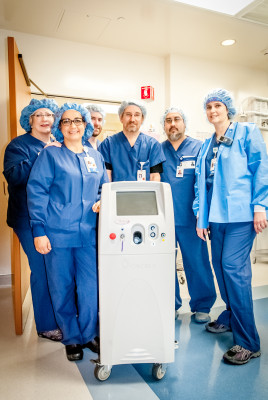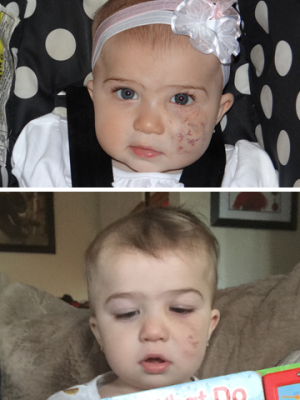
Many babies are born with small blemishes—a little patch of redness here, a birthmark there. While these typically aren’t cause for concern, some cases may become problematic and require extra care.
“If a hemangioma is in a cosmetically sensitive area, or if it’s impairing vision, eating or hearing, it should be referred to a specialist,” according to CHOC plastic surgeon Daniel Jaffurs, MD. “A rapid-growing or large hemangioma should also be referred.”
Casey’s Story

Casey’s parents took her to her pediatrician, who referred her to Dr. Jaffurs. Immediately upon seeing Casey, he diagnosed the marks as infantile hemangiomas and consulted with the rest of the team from the CHOC Vascular Anomalies Center. They recommended that Casey be admitted to CHOC that day for comprehensive testing, to determine the severity of the hemangiomas.
“They started her on propranolol in the hospital and the journey started from there,” mom Michelle says. “It was a year on the medication, and we came to CHOC every single month. The medication was remarkable. It brought down the hemangioma on her face and opened up her eye.”
The growth on Casey’s stomach did not respond as well to the medication and was surgically removed by Dr. Jaffurs. What remained of the hemangioma on Casey’s face, however, could be treated with a simple procedure that had just become available at CHOC.
No Surgery, No Scar
CHOC’s new pulsed dye laser (PDL) is a minimally invasive treatment for hemangiomas, port-wine stains and post-surgical scarring anywhere on the body. The laser delivers very quick pulses of energy at a specific wavelength that is absorbed into the skin, destroying the abnormal blood vessels just below the surface. CHOC uses the latest PDL model—the Vbeam Perfecta— because of its level of precision, which is especially important when lasering sensitive areas like near the eye.

“With this new laser, we sometimes can avoid an operation which leaves a lasting scar,” Dr. Jaffurs says. “And, you can see the results immediately.”
CHOC’s pediatrics-trained anesthesiologists give patients a small amount of anesthesia using a mask, to relax them and minimize movement during the procedure. Patients are sent home the same day; side effects are very minimal and may include slight pain or bruising. The number of treatments needed depends on the location and size of the vascular anomaly.
Casey was one of the first patients at CHOC to be treated with the pulsed dye laser and after just two treatments, the hemangioma on her face is nearly gone. Most patients require three to five treatments depending on the severity of the malformation.
“I want other parents to know that if their child has this, there is a cure for them,” Michelle says. “The team they have at CHOC, it’s just amazing, and if you go there, you’re going to get answers.”
The CHOC Vascular Anomalies Center brings together pediatric specialists in hematology, plastic surgery, head and neck surgery (ENT), dermatology, cardiology and more to assess and treat all forms of vascular anomalies and malformations in children. For more information, call 714-509-3313.




